Kate Burke’s Western History Series
A little fact, a little fiction, told as ‘her’story
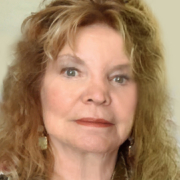
* Designates Keynote Speaker
2024 Presentations
Sept. 16th Whoopin’ it up in Junction!
1 pm. Montrose Senior Center, Montrose Pavilion.
With Joe Zeni. Grand Junction was a popular destination in the early 1900s for exciting entertainment that drew thousands of attendees (most coming by trains) from around the area. Circus, Vaudeville, wrestling, races, aerial extravaganzas, and more.
Excerpts from his new book, Promise, by author and historian, Joe Zeni. Published by San Juan Publishing.
Oct. 7th. WWI Ambulance Service in the Balkans.
1 pm. Montrose Senior Center, Montrose Pavilion.
With Joe Zeni. American volunteers risked their lives to save soldiers and help civilians in the Great War.
Excerpts from his new book, Promise, by author and historian, Joe Zeni. Published by San Juan Publishing.
*Nov. 18th. Silverton: Mining, Madams, and Mayhem.
1 pm. Montrose Senior Center, Montrose Pavilion.
With Kate Burke. A roaring red-light district was the main source of entertainment and the economic engine that fueled the town’s insatiable growth.
Includes handouts.
Programs: January – December, 2023
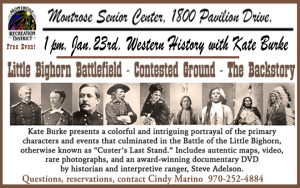 * Little Bighorn, the Back Story
* Little Bighorn, the Back Story
Manifest Destiny, broken treaties, discovery of gold in the Black HIlls, a series of inter-tribal conflicts, and the ongoing fight for natural resources culminated in infamous battle known as Custer’s Last Stand. Guest presenter George Gleason will share information about the monument today. [Read story]
Jan. 23. 1 pm. Montrose Senior Center, Pavilion Drive.
Feb. 25, Noon. Brown bag lunch, WHAFV, 4 Hillcrest Plaza Way
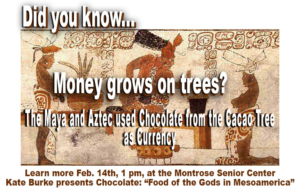 *Chocolate—5,300 years of history for America’s favorite sweet treat
*Chocolate—5,300 years of history for America’s favorite sweet treat
food for the gods, gift of governments and sweethearts. Chocolate has been used for sacrifice, seduction, reverence, and political persuasion. Follow the chocolate trail from its origins in Meso-America,to Europe (where it was first used in solid form because of the Industrial Revolution), to North America, where it has become nearly a $128 billion industry. [Story here]
Feb. 14. 1 pm. Montrose Senior Center, Pavilion Drive.
Feb. 20. Noon. Montrose Woman’s Club, Lions Clubhouse. 602 N. Nevada Ave.
*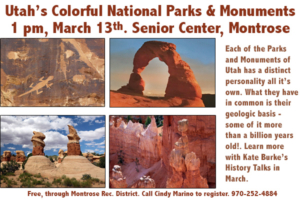 Utah’s Colorful Parks & Monuments
Utah’s Colorful Parks & Monuments
Each of the Parks and Monuments of Utah has a distinct personality all it’s own. What they have in common is their geologic basis – some of it more than a billion years old![Read story]
Mar. 13, 1 pm. Montrose Senior Center, Pavilion Drive
 * Time Banking Explained
* Time Banking Explained
What is it? How does it work? Why should you care? A unique look at a non-monetary economic system that honors time, talent, and community. Learn about Time Dollars, Time Bank Credits, and Time Bank Exchanges—and all the benefits Time Banking has to offer.
Aug. 07. 1 pm. Montrose Senior Center, Pavilion Drive.
Sept. 20. Noon. Montrose Woman’s Club, Lions Clubhouse. 602 N. Nevada Ave.
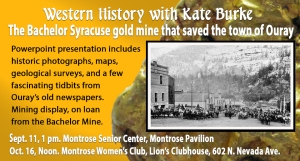 * Ouray’s Goldfields & Bachelor Syracuse Mine.
* Ouray’s Goldfields & Bachelor Syracuse Mine.
Kate Burke’s history series burrows into the history of gold mining and how Ouray’s Bachelor Syracuse Mine saved the town. Today, the mine offers tours into Gold Mountain. PPT, handouts, displays of minerals and mining tools. Copies of book, Tales of the Bachelor Mine, from San Juan Publishing will be available. [Read story]
Sep. 11. 1 pm. Montrose Senior Center, Pavilion Drive.
Oct. 16. Noon. Montrose Woman’s Club, Lions Clubhouse. 602 N. Nevada Ave.
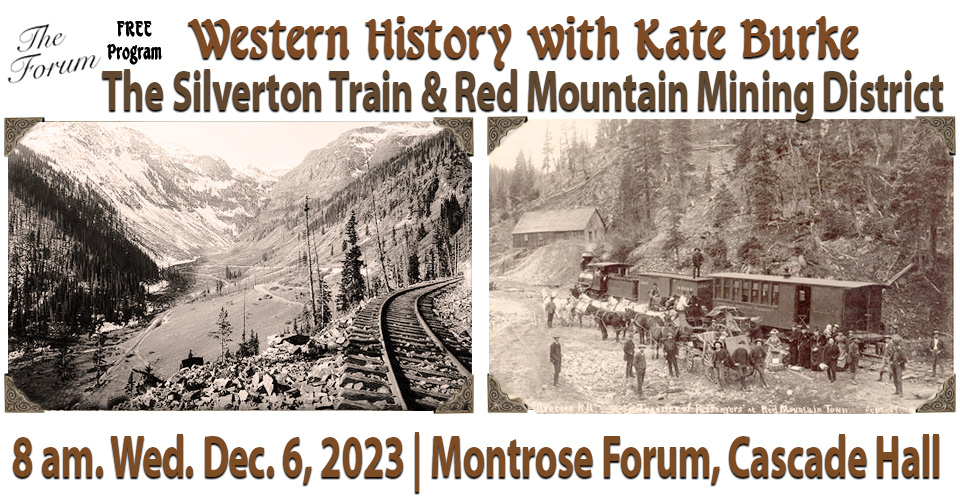 * Silverton Railroad and Red Mountain Mining District.
* Silverton Railroad and Red Mountain Mining District.
Kate Burke’s history series explores explains the how this narrow gauge railroad conquered Red Mountain Pass and the nearly impassable 21.5-mile route between Silveton and Albany in Ouray County. In less than 8 square miles, the Red Mountain District, at its peak, had over 3,000 people and 40 mines! [Story]
Oct. 23. 1 pm. Montrose Senior Center, Pavilion Drive.
Dec. 6, 8 am. The Forum. Cascade Hall, 3rd & Cascade, Montrose
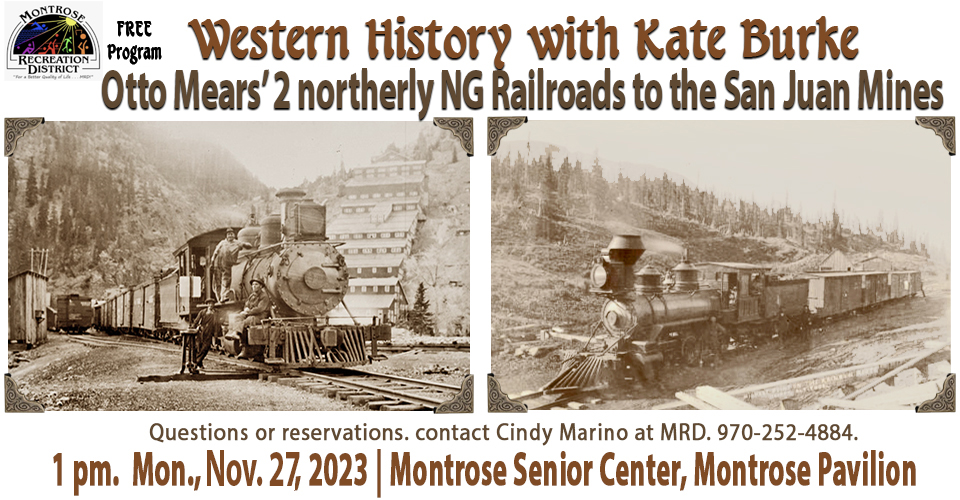 * Otto Mears Other NG Railroads to the Silverton Mining District
* Otto Mears Other NG Railroads to the Silverton Mining District
Kate Burke’s history series continues the saga of the 1880s four narrow gauge trains that served the San Juan Mining District from the 1880s. Climb aboard Otto Mears’ Silverton Northern to Animas Forks, at over 11,000 feet, one of the highest mining camps in North America. Take a ride on the Silverton, Gladstone & Northern, chartered in 1899 by the Gold King Mining Co. and leased by Mears in 1910 to join his Silverton Northern Railroad. [story]
Nov. 23. 1 pm. Montrose Senior Center, Pavilion Drive.
–> Click here for list of topics and presentations, past, present and future.
Talks are 30-40 minutes with 5-10-minute introduction and 15-30 minutes Q&A time afterward. Presentations include Power Point, sometimes video Internet Youtube or weblinks. Related handouts. Presentations must be scheduled at least 30 days in advance, and I do charge a speakers fee.
Topics include history and travel, with interesting takes on both. The most popular focus on our own regional history—hard rock mining, narrow gauge railroads, farming and homesteading, multi-generational families and their related activities. And, of course, whenever appropriate, I try to connect it all to arts and entertainment.
Not talks are in Montrose. As presentations are scheduled elsewhere, they will be listed here.
